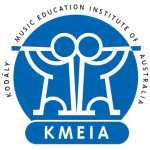- Presentation: Awards for Excellence in Australian Kodály-inspired Music Education
- Conference Choir Rehearsal – Tracy Wong & Mark O’Leary
Day 3
All conference delegates will form part of the 2024 Conference Choir, led by renowned conductors Tracy Wong (Canada/Malaysia) and Mark O’Leary OAM. The choir will rehearse two pieces, including a new conference commission by Juliana Kay, and perform at the choir concert on the Wednesday evening.
- He Hononga – Making Connections – Megan Flint
- Music Without Barriers: Found percussion for everyone – Kaboom Percussion
- Enhancing Language Skills through Music – Ebony Birch-Hanger
- Music for All: a rejuvenation of authentic, culturally diverse music making in the Early Years, supported by the Music Education Strategy in South Australia – Gaby Freer & Alexandra Dalman
- Sing the Story, Sing to Inspire! Two-part and Unison Songs for Your Choir – Hayley Blakiston & Marion Stafford
- Like a Version: Upper Primary/Lower Secondary Unit – Alex St Vincent Welch
The New Zealand Curriculum requires educators to give effect to The Treaty of Waitangi through both programmes and pedagogy. This means ensuring that all curriculum programmes create space for matauranga Māori (Māori knowledge) and tikanga Māori (Māori ways of doing and being). As tangata tiriti, a non-Maori partner to the Treaty, committed to upholding the spirit, values and promises of our nation’s founding document, what does this mean for me in the music classroom? In this interactive workshop, I share examples from my teaching practice that demonstrate how I am working to weave mātauranga Māori into my Kodály-inspired primary music programme.
Join Kaboom Percussion founders Cat and Josh as we take you through our strategies for engaging students and developing musical skills through the use of found percussion.
We love showing students that music is for everyone, and we firmly believe that one of the best ways to do this is by making music with simple household items. Found percussion promotes inclusivity by removing barriers for individuals of all ages, abilities, and socio-economic backgrounds.
In this hands-on workshop, we will share some of our favourite tried-and-tested activities which explore rhythm, coordination, teamwork, and the joy of performance. Come have some fun making music together with exercises you’ll be able to use in your classroom immediately!
Movement within a music program serves many functions. It encourages mindfulness, kinesthetic understanding of musical concepts, focus, ability to work with others, sensitivity to music, listening skills and of course music appreciation. Creative Movement requires well-established parameters and classroom rules along with the development of a vocabulary/repertoire provided by the teacher. Establishing a sequential plan for the introduction and development of movement skills ensures success, enjoyment and above all sensitive, creative young musicians.

South Australia is leading the way in creating new pathways for generalist teachers and preschool educators in improving their teaching practice in Music. The Department for Education is the first in Australia to fund and create a Music Education Strategy in order to give all children access to high quality music education. Gaby Freer and Alexandra Dalman, both experienced Kodály-inspired practitioners, work full time for the Music Education Strategy as network field officers, building capacity and confidence in teachers, especially in Early Years and Junior Primary. In this session, participants will expect to gain insight into the workings of the Strategy through an interactive workshop where we move, sing and play. We will be focusing on repertoire for Early Years we use, within multicultural diverse communities and schools, including some songs written in collaboration with teachers and Elders from Kaurna land. Our practice is research informed, modern in its approach and strongly connected to the communities and schools we support.
Kodaly’s love and appreciation of music for everyone was inspiring, as was his mission to preserve the songs of the people. He believed that music education could engage students on a spiritual, cultural, and emotional level. Choosing repertoire for your choir embodies this. It not only builds their music skills but also broadens their understanding of our country. In this session, you will discover beautiful unison and two-part choral repertoire by Australian composers that you can use with your upper primary choir (Years 4 – 6) on different occasions throughout the year. Some pieces can be learnt in a few rehearsals, while others will take time and develop their capacity. Let’s have fun singing through repertoire that will educate, inspire and engage!
How do musicians transform existing ideas into something fresh and original? This unit, designed for upper primary and lower secondary students, focuses on concepts like theme and variations, quotation, sampling, and interpolation. It emphasizes composing with the help of basic tech tools while exploring how these techniques are used across genres such as classical, jazz, pop, and film soundtracks. These musical styles serve as excellent examples for students to study and apply in their own creative work.
